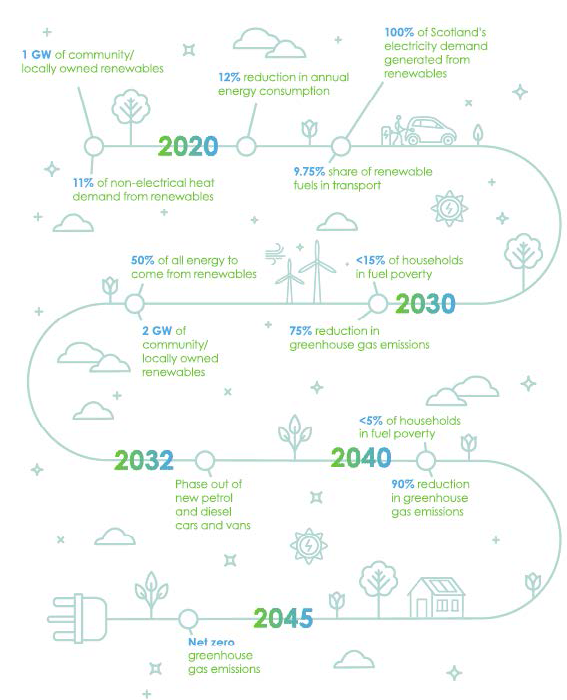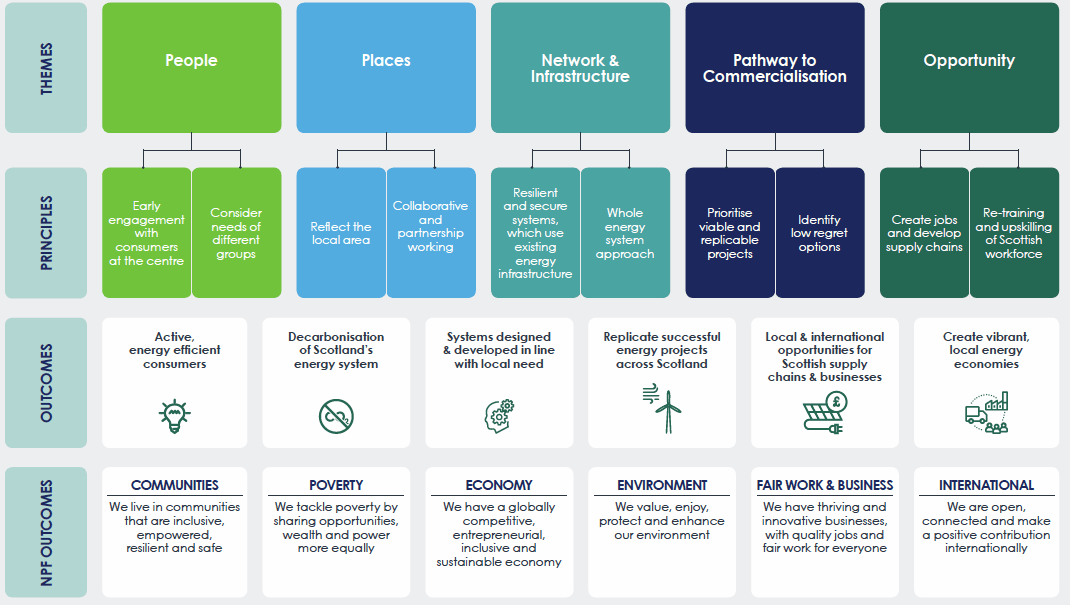Local energy policy statement
This local energy policy statement containing set of key principles and associated outcomes represents the values we wish to see adopted.
Context
Scotland's energy system is changing, with a shift away from power generated from fossil fuel plants to substantial increases in renewable generation. This means there will be a greater role for considering local energy solutions to meet local energy needs.
The journey to net zero is fast moving both in terms of technology development and its supporting infrastructure. As such, it is difficult to predict exactly how it will develop.
What is clear however, is the way that we generate supply and use our energy will continue to change fundamentally in the coming years, and these changes will differ from place to place - based on local need and opportunity.
In this transitional phase, we must not lose sight that our overall approach to energy is driven by the need to decarbonise the whole energy system. This is in line with Scotland's target to reach net-zero emissions of all greenhouse gases by 2045, set under the Climate Change (Emissions Reduction Targets) (Scotland) Act 2019[1].
The Scottish Government recognises that local energy cannot be delivered in isolation. It is not a standalone policy but one that integrates and aligns with other key Scottish Government policies including, energy efficiency, eradicating fuel poverty, heat decarbonisation, local heat and energy efficiencies strategies and consumer protection. In addition, it will develop alongside (and within) a vibrant national energy network.
In summary, the local energy landscape is complex, and involves a range of different links, relationships and interdependencies which this statement seeks to explain. This is critical to ensuring that Scotland can transition to a net zero future by 2045 in a way that delivers secure, affordable, clean energy for Scotland.
Review
We will review the statement after 3 years to ensure it remains relevant.
Definitions
For the purposes of this statement the following definitions are used:
Community energy is the delivery of community-led renewable energy projects, whether wholly owned and/ or controlled by communities, or through partnerships with commercial or public sector partners. The Scottish Government views community-led energy projects as a priority within the wider local energy landscape.
Local energy is more wide ranging, involving a range of different organisations (public, private, and community sector), who are delivering an energy service/project for the benefit of local people operating within a defined geographical area.
Local energy systems are ones which find ways to link the supply and demand of energy services within an area across electricity, heat and transport, delivers real value to everyone in local areas, and support the growth of vibrant, net zero local economies.
Local Energy Stakeholders
There are a wide range of stakeholders involved in developing, delivering and interacting with local energy projects. These include people and organisations, ranging from individual energy consumers to network operators, and from community organisations to large energy generators and suppliers, as highlighted below:
- Energy consumers (Domestic & Non-Domestic)
- Local & National Government
- Industry Regulators
- Energy Network Operators (Gas and Electricity)
- Distribution/Transmission System Operators
- Public Sector Agencies
- Community Groups
- Project Developers
- Energy Generators
- Energy Suppliers
- Supply Chains
- Third Sector Groups
- Transport Sector
- Construction Sector
- Land Owners
- House Builders
A common request from the consultation was for the roles and responsibilities of different stakeholders to be clarified and we have undertaken to do this.
We will
- Set out a framework outlining stakeholders' roles and responsibilities.

Key Principles
People
Undertake early engagement with people who will be involved, directly and indirectly.
Recognise and tailor support to the different ways people will want to engage.
Places
Local energy projects should reflect local characteristics.
Focus on collaborative strategic approaches and partnership working.
Network & Infrastructure
All activity should provide a high level of security and quality of supply to all, with an emphasis on consideration of existing energy infrastructure first.
The design and operation of energy networks should consider the whole energy system while supporting local, regional and national solutions.
Pathway to Commercialisation
Prioritise projects that demonstrate a commercially viable and replicable opportunity, in line with the principle of inclusive growth.
Prioritise and act upon “low regret” opportunities that support net zero emissions.
Opportunity
Local energy projects should seek to support the creation of high value jobs, including the development of the Scottish supply chain.
Any changes to the energy system should ensure a just transition for Scotland’s workforce.
We Will
Include a requirement in the next CARES contract to establish a register to promote the adoption of our Principles and monitor progress.
Ensure the Principles are aligned with Local Heat and Energy Efficiency Strategies (LHEES).
Ensure that that the next CARES contract promotes the adoption of our Principles.

Contact
Email: ashton.blackburn@gov.scot
There is a problem
Thanks for your feedback